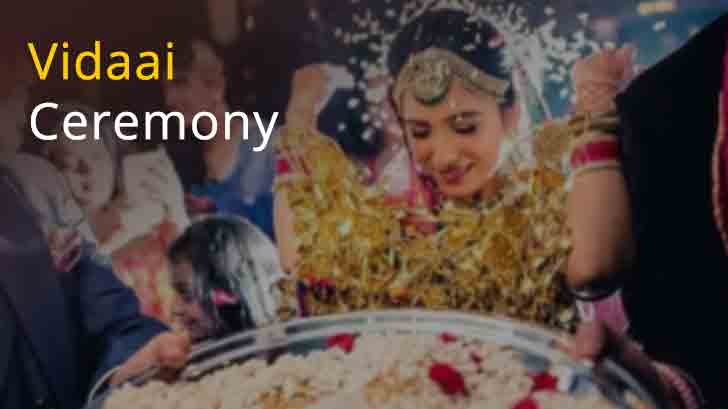-
Customer Care 9999 091 091
- Consult Now
-
Notifications
-

Vidaai is the ritual which translates to “goodbye” or “farewell”. Vidaai ceremony symbolizes the final stage of a Hindu wedding where the parents of the bride bid farewell to their daughter. It also symbolizes the new beginnings in the life of the bride and to maintain a balance between her old and new life. This is one of the most emotional moments of the wedding day.
When we think of Indian weddings, we cannot expect anything but elaborate, lavish arrangements, and unique rituals. Especially a Hindu wedding ceremony begins and ends with a number of ceremonies and rituals, where family and friends come together to wish and bless the couple for their new beginnings. You can’t imagine a single wedding without loads of rituals and celebrations. Most of the family members as well as the bride and groom are occupied in performing various rituals.
The wedding is also a day where the numbers of emotions are intertwined. The memories of weddings are special and remain forever. One such memory that has mixed emotions of joy and sorrow is the Vidaai ritual - a post-wedding ceremony that takes place after the wedding rituals are completed.
During the Kanyadaan ceremony the father of the bride gives her daughter’s hands away to the groom, symbolically, however, Vidaai is the official sendoff for his daughter.
Vidaai is also known as Bidaai, based on which region the ritual is being celebrated.
No matter how far or less the distance is between her in-law's house and her maternal house, almost every bride cries during vidaai. Of course, the idea of being separated from her parents and her family is certainly heart-wrenching.
Once all the wedding rituals are over, the family and relatives accompany the bride to the exit of the wedding venue, the parents leading the pack holding their daughter close. They request the groom to take care of their daughter and always be there to support and guide her in their marital journey.
Before crossing the doorstep, the bride throws a handful of rice and coins three times over her head behind her toward her parent’s home. This act is supposed to symbolize repayment and gratitude to her parents for bringing her up with so much love and care and giving her everything throughout the years. This also represents that she wishes her parents' house to always remain happy and prosperous.
She hugs her parents and touches the feet of the elderly relatives as a gesture of seeking blessings for her new life ahead.
The final ritual in the vidaai ceremony sees the couple step into a well-decorated car for the occasion and commence their final farewell. The brothers and cousins of the bride push the car from behind as a way of wishing her luck and pushing the couple towards their new voyage of marital bliss, and the joy and prosperity in life.
When the groom’s car takes forward, often the bride’s family and wedding guests throw some coins on the road to ward off evil eyes from her path towards her brand new life.
In some communities, the brother of the bride accompanies his sister to drop her to her husband’s home. Stays overnight and returns back the next day.
The vidaai ceremony is symbolic of the final stage of a marriage ceremony (for the bride’s side, yes, thereafter there’s more rituals from the groom’s side) where the parents of the bride bid farewell to their daughter with their son-in-law. Brides are considered the manifestation of Goddess Lakshmi as per the Hindu religion. She is the deity of wealth and prosperity and is observed during the Vidaai ritual in order to ensure that her family preserves the values of wealth and prosperity as she leaves them for her new home. It is a symbol of the bride wishing for her parent's home to always remain healthy, wealthy, and prosperous. This ritual also marks the beginning of the bride’s life as a wife.
Vidaai is unarguably the most sentimental part of any wedding. It is the moment of truth! On the flip side, vidaai is a happy fact that it’s the beginning of the couple's life as husband and wife.